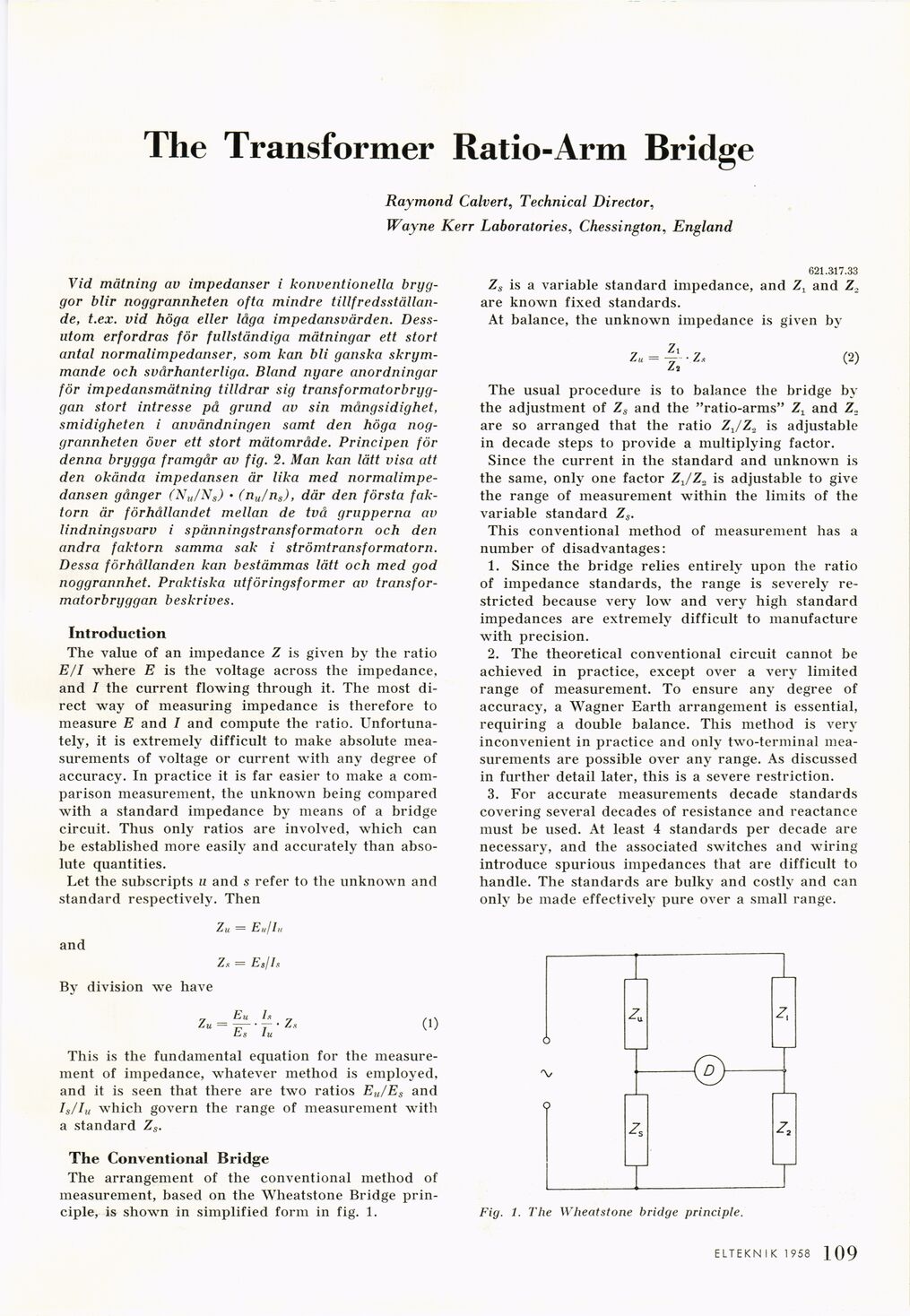
Full resolution (JPEG) - On this page / på denna sida - 1958, H. 8 - The Transformer Ratio-arm Bridge, by Raymond Calvert

<< prev. page << föreg. sida << >> nästa sida >> next page >>
Below is the raw OCR text
from the above scanned image.
Do you see an error? Proofread the page now!
Här nedan syns maskintolkade texten från faksimilbilden ovan.
Ser du något fel? Korrekturläs sidan nu!
This page has never been proofread. / Denna sida har aldrig korrekturlästs.
The Transformer Ratio-Arm Bridge
Raymond Calvert, Technical Director,
Wayne Kerr Laboratories, Chessington, England
Vid mätning av impedanser i konventionella
bryggor blir noggrannheten ofta mindre
tillfredsställande, t.ex. vid höga eller låga impedansvärden.
Dessutom erfordras för fullständiga mätningar ett stort
antal normalimpedanser, som kan bli ganska
skrymmande och svårhanterliga. Bland nyare anordningar
för impedansmätning tilldrar sig
transformatorbryggan stort intresse på grund av sin mångsidighet,
smidigheten i användningen samt den höga
noggrannheten över ett stort mätområde. Principen för
denna brygga framgår av fig. 2. Man kan lätt visa att
den okända impedansen är lika med
normalimpedansen gånger (Nu/Ns) • (nu/ns), där den första
faktorn är förhållandet mellan de två grupperna av
lindningsvarv i spänningstransformatorn och den
andra faktorn samma sak i strömtransformatorn.
Dessa förhållanden kan bestämmas lätt och med god
noggrannhet. Praktiska utföringsformer av
transformatorbryggan beskrives.
Introduction
The value of an impedance Z is given by the ratio
E/I where E is the voltage across the impedance,
and I the current flowing through it. The most
direct way of measuring impedance is therefore to
measure E and I and compute the ratio.
Unfortunately, it is extremely difficult to make absolute
measurements of voltage or current with any degree of
accuracy. In practice it is far easier to make a
comparison measurement, the unknown being compared
with a standard impedance by means of a bridge
circuit. Thus only ratios are involved, which can
be established more easily and accurately than
absolute quantities.
Let the subscripts u and s refer to the unknown and
standard respectively. Then
Zu = Elli In
and
Z, = E»fh
By division we have
This is the fundamental equation for the
measurement of impedance, whatever method is employed,
and it is seen that there are two ratios E„/Es and
Is/lu which govern the range of measurement with
a standard Zs.
The Conventional Bridge
The arrangement of the conventional method of
measurement, based on the Wheatstone Bridge
principle, is shown in simplified form in fig. 1.
621.317.33
Zs is a variable standard impedance, and Z1 and Z2
are known fixed standards.
At balance, the unknown impedance is given by
ZU = |V-Z, (2)
The usual procedure is to balance the bridge by
the adjustment of Zs and the "ratio-arms" Zx and Z„
are so arranged that the ratio ZJZ.2 is adjustable
in decade steps to provide a multiplying factor.
Since the current in the standard and unknown is
the same, only one factor Z1/Z„ is adjustable to give
the range of measurement within the limits of the
variable standard Zs.
This conventional method of measurement has a
number of disadvantages:
1. Since the bridge relies entirely upon the ratio
of impedance standards, the range is severely
restricted because very low and very high standard
impedances are extremely difficult to manufacture
with precision.
2. The theoretical conventional circuit cannot be
achieved in practice, except over a very limited
range of measurement. To ensure any degree of
accuracy, a Wagner Earth arrangement is essential,
requiring a double balance. This method is very
inconvenient in practice and only two-terminal
measurements are possible over any range. As discussed
in further detail later, this is a severe restriction.
3. For accurate measurements decade standards
covering several decades of resistance and reactance
must be used. At least 4 standards per decade are
necessary, and the associated switches and wiring
introduce spurious impedances that are difficult to
handle. The standards are bulky and costly and can
only be made effectively pure over a small range.
Fig. 1. The Wheatstone bridge principle.
ELTEKN I K 1958 7 ]
<< prev. page << föreg. sida << >> nästa sida >> next page >>